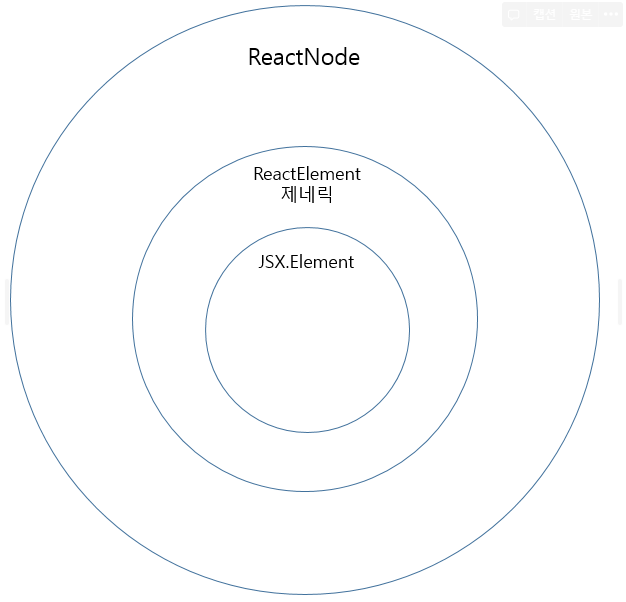개요
React 컴포넌트의 타입을 결정할 때 ReactNode, JSX.Element 등의 여러 타입이 있다.
각 타입의 차이점을 이해하고, 상황에 맞게 타입을 정의하고자 글을 작성하였다.
React 컴포넌트 타입 종류
- ReactElement
- JSX.Element
- ReactNode
- ReactChild
- ReactFragment
- ReactPortal
- ComponentType
ReactElement
interface ReactElement<P = any, T extends string | JSXElementConstructor<any> = string | JSXElementConstructor<any>>
{
type: T;
props: P;
key: Key | null;
}
const createElement: ReactElement = React.createElement('div', { className: 'name' }, 'React');
const jsx: ReactElement = <div className="name">React</div>;ReactElement는 React.createElement를 호출하거나 JSX 문법을 사용해서 만든 객체의 인터페이스 이며, 이 객체는 type, props를 가지고 있다.
함수형 컴포넌트는 ReactElement를 반환하고, 클래스형 컴포넌트는 ReactNode를 반환한다.
JSX.Element
declare global {
namespace JSX {
interface Element extends React.ReactElement<any, any> {}
}
}JSX.Element는 props와 type이 any인 제네릭 타입을 가진 ReactElement 이다.
JSX는 global namespace에 있기 때문에 다양한 라이브러리에서 자체 라이브러리의 방법대로 실행될 수 있다.
ReactNode
type ReactNode = ReactChild | ReactFragment | ReactPortal | boolean | null | undefined;ReactNode는 ReactElement의 superset 이다.
ReactChild, ReactFragment, ReactPortal, boolean, null, undefined 유니언 타입을 가지고 있다.
따라서, children을 사용하는 컴포넌트에서 children의 타입을 ReactNode로 정의해주는 경우가 많다.
ReactElement, JSX.Element, ReactNode 의 관계

ReactNode는 ReactElement의 superset이고, JSX.Element는 제네릭 타입을 가진 ReactElement 이므로, 이 셋의 관계는 위의 이미지와 같다.
ReactChild
type ReactText = string | number;
type ReactChild = ReactElement | ReactText;ReactChild는 ReactElement, ReactText 유니언 타입을 가지고 있으며,
ReactText는 string, number 타입을 가지고 있다.
ReactFragment
interface ReactNodeArray extends Array<ReactNode> {}
type ReactFragment = {} | ReactNodeArray;ReactFragment는 object, ReactNodeArray 유니언 타입을 가지고 있으며,
ReactNodeArray는 배열 형태의 ReactNode 타입이다.
ReactPortal
interface ReactPortal extends ReactElement {
key: Key | null;
children: ReactNode;
}ReactPortal은 ReactElement를 상속 받아 props, type, children을 가지고 있는 객체의 인터페이스 이다.
children에는 ReactNode 타입이 정의되어 있다.
- React의 Portal 이란? 컴포넌트를 렌더링 할 때, DOM을 선택하여 부모 컴포넌트의 바깥에서도 렌더링 할 수 있게 해주는 기능. Portals - React
ComponentType
type ComponentType<P = {}> = ComponentClass<P> | FunctionComponent<P>;ComponentType은 클래스형 컴포넌트, 함수형 컴포넌트 유니언 타입을 가지고 있으며,
컴포넌트의 props에 대한 제네릭 타입을 정의할 수 있다.
